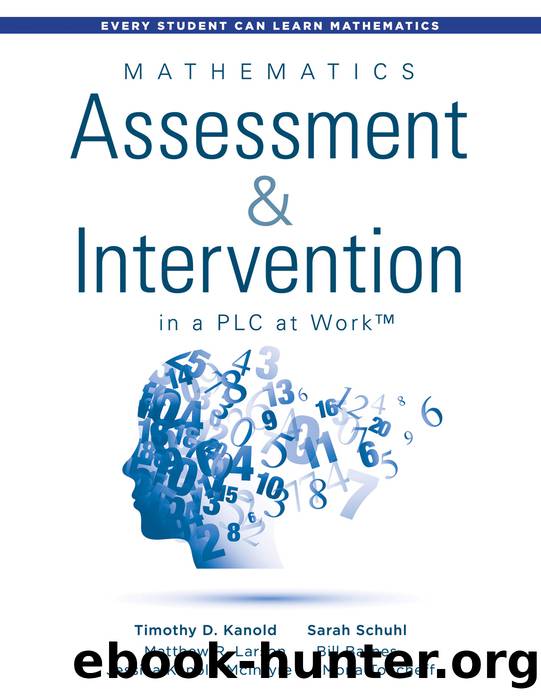Mathematics Assessment and Intervention in a PLC at Work(tm) by unknow

Author:unknow
Language: eng
Format: epub
Publisher: Solution Tree
Published: 2018-08-15T00:00:00+00:00
Figure 3.7: Proficiency scale for grade 1 common mid-unit assessment sample in figure 3.1.
Personal StoryââSARAH SCHUHL
In my work with teams, I have learned that proficiency scales are not always easy to create, but they provide rich opportunities for teachers to talk about what students have to know and be able to do to be proficient with the mathematics standards.
At a recent high school collaborative team meeting with a team transitioning to proficiency-scaled assessments, the teachers wanted my opinion on their scale. The scale did not reference a total number of points needed for the essential learning standard portion of the assessment. Interestingly, the scale also did not reference student learning levels related to the standard. Instead, the proficiency scale identified which questions a student had to answer correctly to earn a score of 1, 2, 3, or 4. For example, students earned a 1 if they answered questions 1 and 2 correctly, a 2 if they also answered question 3 correctly, and a 3 if they also answered question 4 correctly. Question 5 was beyond the intent of the standard, so if students answered all five questions correctly, they earned a 4 on the proficiency scale. On such a scale, what happens if a student only answers question 3 correctly? Or question 5? What happens if a student misses the first question and the rest are perfect?
As we wrestled with the options, it became clear the team was going to need to create a scale showing the type of learning evidence a student produces for each level 1â4. We looked at a rubric from ThemeSpark (www.themespark.net) and revised it as needed, noting that a proficient student might still make some simple mistakes and need additional practice, but is not in need of re-teaching.
The team also decided not to assess level 4 on the end-of-unit common assessment but rather as a separate test. This would allow them to ask more questions at grade level and make sure students did not spend too much time on questions beyond the intent of the standards at the expense of having time to demonstrate learning on other essential standards. Instead, the team created five questions, some at a low level and others at a high level (but not beyond the intent of the essential mathematics standards). Team members did this only after they made their proficiency scale, so they could discuss the type of work expected for a student to earn a score of 1, 2, or 3 using the preponderance of evidence produced by the student on that portion of the exam.
Download
This site does not store any files on its server. We only index and link to content provided by other sites. Please contact the content providers to delete copyright contents if any and email us, we'll remove relevant links or contents immediately.
| Applied | Geometry & Topology |
| History | Infinity |
| Mathematical Analysis | Matrices |
| Number Systems | Popular & Elementary |
| Pure Mathematics | Reference |
| Research | Study & Teaching |
| Transformations | Trigonometry |
Modelling of Convective Heat and Mass Transfer in Rotating Flows by Igor V. Shevchuk(6391)
Weapons of Math Destruction by Cathy O'Neil(6147)
Factfulness: Ten Reasons We're Wrong About the World – and Why Things Are Better Than You Think by Hans Rosling(4694)
Descartes' Error by Antonio Damasio(3230)
A Mind For Numbers: How to Excel at Math and Science (Even If You Flunked Algebra) by Barbara Oakley(3221)
Factfulness_Ten Reasons We're Wrong About the World_and Why Things Are Better Than You Think by Hans Rosling(3199)
TCP IP by Todd Lammle(3134)
Fooled by Randomness: The Hidden Role of Chance in Life and in the Markets by Nassim Nicholas Taleb(3045)
Applied Predictive Modeling by Max Kuhn & Kjell Johnson(3018)
The Tyranny of Metrics by Jerry Z. Muller(3002)
The Book of Numbers by Peter Bentley(2912)
The Great Unknown by Marcus du Sautoy(2648)
Once Upon an Algorithm by Martin Erwig(2599)
Easy Algebra Step-by-Step by Sandra Luna McCune(2585)
Lady Luck by Kristen Ashley(2534)
Practical Guide To Principal Component Methods in R (Multivariate Analysis Book 2) by Alboukadel Kassambara(2497)
Police Exams Prep 2018-2019 by Kaplan Test Prep(2487)
All Things Reconsidered by Bill Thompson III(2357)
Linear Time-Invariant Systems, Behaviors and Modules by Ulrich Oberst & Martin Scheicher & Ingrid Scheicher(2334)
